Potential of EnMAP Hyperspectral Imagery for Regional-Scale Soil Organic Matter Mapping
Abstract
1. Introduction
2. Materials and Methods
2.1. Study Area
2.2. Soil Sampling and Analysis
2.3. Environmental Mapping and Analysis Program (EnMAP)
2.4. Data Preprocessing
2.5. Predictive Modeling and Feature Selection
3. Results
3.1. Soil and Spectral Data
3.2. Smoothing Effect
3.3. Predictive Modeling Performance
3.4. Spatial Prediction of SOM
4. Discussion
4.1. Wavelengths Important for SOM Prediction
4.2. Predictive Approach
5. Limitations and Future Research
6. Conclusions
Author Contributions
Funding
Data Availability Statement
Acknowledgments
Conflicts of Interest
References
- Bhattacharyya, S.S.; Ros, G.H.; Furtak, K.; Iqbal, H.M.; Parra-Saldívar, R. Soil carbon sequestration–An interplay between soil microbial community and soil organic matter dynamics. Sci. Total Environ. 2022, 815, 152928. [Google Scholar] [CrossRef]
- John, K.; Bouslihim, Y.; Ofem, K.I.; Hssaini, L.; Razouk, R.; Okon, P.B.; Isong, I.A.; Agyeman, P.C.; Kebonye, N.M.; Qin, C. Do model choice and sample ratios separately or simultaneously influence soil organic matter prediction? Int. Soil Water Conserv. Res. 2021, 10, 470–486. [Google Scholar] [CrossRef]
- Das, S.; Kim, P.J.; Nie, M.; Chabbi, A. Soil organic matter in the anthropocene: Role in climate change mitigation, carbon sequestration, and food security. Agric. Ecosyst. Environ. 2024, 375, 109180. [Google Scholar] [CrossRef]
- Minasny, B.; McBratney, A.B.; Arrouays, D.; Chabbi, A.; Field, D.J.; Kopittke, P.M.; Morgan, C.L.; Padarian, J.; Rumpel, C. Soil carbon se-questration: Much more than a climate solution. Environ. Sci. Technol. 2023, 57, 19094–19098. [Google Scholar] [CrossRef]
- Conant, R.T.; Ogle, S.M.; Paul, E.A.; Paustian, K. Measuring and monitoring soil organic carbon stocks in agricultural lands for climate mitigation. Front. Ecol. Environ. 2010, 9, 169–173. [Google Scholar] [CrossRef]
- Peng, L.; Wu, X.; Feng, C.; Gao, L.; Li, Q.; Xu, J.; Li, B. Assessing the potential of multi-source remote sensing data for cropland soil organic matter mapping in hilly and mountainous areas. Catena 2024, 245, 108312. [Google Scholar] [CrossRef]
- Ben-Dor, E.; Chabrillat, S.; Demattê, J.; Taylor, G.; Hill, J.; Whiting, M.; Sommer, S. Using Imaging Spectroscopy to study soil properties. Remote Sens. Environ. 2009, 113, S38–S55. [Google Scholar] [CrossRef]
- Ng, W.; Minasny, B.; Montazerolghaem, M.; Padarian, J.; Ferguson, R.; Bailey, S.; McBratney, A.B. Convolutional neural network for simultaneous prediction of several soil properties using visible/near-infrared, mid-infrared, and their combined spectra. Geoderma 2019, 352, 251–267. [Google Scholar] [CrossRef]
- Yang, M.; Chen, S.; Xu, D.; Hong, Y.; Li, S.; Peng, J.; Ji, W.; Guo, X.; Zhao, X.; Shi, Z. Strategies for predicting soil organic matter in the field using the Chinese Vis-NIR soil spectral library. Geoderma 2023, 433, 116461. [Google Scholar] [CrossRef]
- Chabrillat, S.; Ben-Dor, E.; Cierniewski, J.; Gomez, C.; Schmid, T.; van Wesemael, B. Imaging Spectroscopy for Soil Mapping and Monitoring. Surv. Geophys. 2019, 40, 361–399. [Google Scholar] [CrossRef]
- John, K.; Bouslihim, Y.; Isong, I.A.; Hssaini, L.; Razouk, R.; Kebonye, N.M.; Agyeman, P.C.; Penížek, V.; Zádorová, T. Mapping soil nutrients via different covariates combinations: Theory and an example from Morocco. Ecol. Process. 2022, 11, 23. [Google Scholar] [CrossRef]
- Castaldi, F.; Hueni, A.; Chabrillat, S.; Ward, K.; Buttafuoco, G.; Bomans, B.; Vreys, K.; Brell, M.; van Wesemael, B. Evaluating the capability of the Sentinel 2 data for soil organic carbon prediction in croplands. ISPRS J. Photogramm. Remote Sens. 2019, 147, 267–282. [Google Scholar] [CrossRef]
- Gholizadeh, A.; Žižala, D.; Saberioon, M.; Borůvka, L. Soil organic carbon and texture retrieving and mapping using proximal, airborne and Sentinel-2 spectral imaging. Remote Sens. Environ. 2018, 218, 89–103. [Google Scholar] [CrossRef]
- Bouasria, A.; Namr, K.I.; Rahimi, A.; Ettachfini, E.M.; Rerhou, B. Evaluation of Landsat 8 image pansharpening in estimating soil organic matter using multiple linear regression and artificial neural networks. Geo Spat. Inf. Sci. 2022, 25, 353–364. [Google Scholar] [CrossRef]
- Bouslihim, Y.; John, K.; Miftah, A.; Azmi, R.; Aboutayeb, R.; Bouasria, A.; Razouk, R.; Hssaini, L. The effect of covariates on Soil Organic Matter and pH variability: A digital soil mapping approach using random forest model. Ann. GIS 2024, 30, 215–232. [Google Scholar] [CrossRef]
- Lin, C.; Zhu, A.-X.; Wang, Z.; Wang, X.; Ma, R. The refined spatiotemporal representation of soil organic matter based on remote images fusion of Sentinel-2 and Sentinel-3. Int. J. Appl. Earth Obs. Geoinf. 2020, 89, 102094. [Google Scholar]
- Zhou, T.; Geng, Y.; Chen, J.; Pan, J.; Haase, D.; Lausch, A. High-resolution digital mapping of soil organic carbon and soil total nitrogen using DEM derivatives, Sentinel-1 and Sentinel-2 data based on machine learning algorithms. Sci. Total Environ. 2020, 729, 138244. [Google Scholar] [CrossRef]
- Luo, C.; Zhang, W.; Zhang, X.; Liu, H. Mapping of soil organic matter in a typical black soil area using Landsat-8 synthetic images at different time periods. Catena 2023, 231, 107336. [Google Scholar] [CrossRef]
- Casa, R.; Castaldi, F.; Pascucci, S.; Palombo, A.; Pignatti, S. A comparison of sensor resolution and calibration strategies for soil texture estimation from hyperspectral remote sensing. Geoderma 2013, 197–198, 17–26. [Google Scholar] [CrossRef]
- Castaldi, F.; Palombo, A.; Santini, F.; Pascucci, S.; Pignatti, S.; Casa, R. Evaluation of the potential of the current and forthcoming multispectral and hyperspectral imagers to estimate soil texture and organic carbon. Remote Sens. Environ. 2016, 179, 54–65. [Google Scholar] [CrossRef]
- Gomez, C.; Rossel, R.A.V.; McBratney, A.B. Soil organic carbon prediction by hyperspectral remote sensing and field vis-NIR spectroscopy: An Australian case study. Geoderma 2008, 146, 403–411. [Google Scholar] [CrossRef]
- Rossel, R.A.V.; Lee, J.; Behrens, T.; Luo, Z.; Baldock, J.; Richards, A. Continental-scale soil carbon composition and vulnerability modulated by regional environmental controls. Nat. Geosci. 2019, 12, 547–552. [Google Scholar] [CrossRef]
- Yue, M.; Qi-gang, J.; Zhi-guo, M.; Hua-xin, L. Black soil organic matter content estimation using hybrid selection method based on rf and gabpso. Spectrosc. Spectr. Anal. 2018, 38, 181–187. [Google Scholar]
- Wang, S.-F.; Cheng, X.; Song, H.-Y. Analysis of the Effect of Moisture on Soil Organic Matter Determination and Anti-Moisture Interference Model Building Based on Vis-NIR Spectral Technology. Guang Pu Xue Yu Guang Pu Fen Xi Guang Pu 2016, 36, 3249–3253. [Google Scholar]
- Wang, Y.-P.; Lee, C.-K.; Dai, Y.-H.; Shen, Y. Effect of wetting on the determination of soil organic matter content using visible and near-infrared spectrometer. Geoderma 2020, 376, 114528. [Google Scholar] [CrossRef]
- Ben-Dor, E.; Inbar, Y.; Chen, Y. The reflectance spectra of organic matter in the visible near-infrared and short wave infrared region (400–2500 nm) during a controlled decomposition process. Remote Sens. Environ. 1997, 61, 1–15. [Google Scholar] [CrossRef]
- Xu, L.; Hong, Y.; Wei, Y.; Guo, L.; Shi, T.; Liu, Y.; Jiang, Q.; Fei, T.; Liu, Y.; Mouazen, A.M.; et al. Estimation of Organic Carbon in Anthropogenic Soil by VIS-NIR Spectroscopy: Effect of Variable Selection. Remote Sens. 2020, 12, 3394. [Google Scholar] [CrossRef]
- Rinnan, Å.; van den Berg, F.; Engelsen, S.B. Review of the most common pre-processing techniques for near-infrared spectra. TrAC Trends Anal. Chem. 2009, 28, 1201–1222. [Google Scholar] [CrossRef]
- Rossel, R.V.; Behrens, T. Using data mining to model and interpret soil diffuse reflectance spectra. Geoderma 2010, 158, 46–54. [Google Scholar] [CrossRef]
- Guo, H.; Zhang, R.; Dai, W.; Zhou, X.; Zhang, D.; Yang, Y.; Cui, J. Mapping Soil Organic Matter Content Based on Feature Band Selection with ZY1-02D Hyperspectral Satellite Data in the Agricultural Region. Agronomy 2022, 12, 2111. [Google Scholar] [CrossRef]
- Gasmi, A.; Gomez, C.; Chehbouni, A.; Dhiba, D.; El Gharous, M. Using PRISMA Hyperspectral Satellite Imagery and GIS Approaches for Soil Fertility Mapping (FertiMap) in Northern Morocco. Remote Sens. 2022, 14, 4080. [Google Scholar] [CrossRef]
- Meng, X.; Bao, Y.; Ye, Q.; Liu, H.; Zhang, X.; Tang, H.; Zhang, X. Soil Organic Matter Prediction Model with Satellite Hyperspectral Image Based on Optimized Denoising Method. Remote Sens. 2021, 13, 2273. [Google Scholar] [CrossRef]
- Chen, R.; Xue, W.; Zi-Wen, W.; Hao, Q.; Tie-Min, M.; Zheng-Guang, C. Wavelength selection method of near-infrared spectrum based on random forest feature importance and interval partial least square method. Spectrosc. Spectr. Anal 2023, 43, 1043–1050. [Google Scholar]
- Shi, Y.; Zhao, J.; Song, X.; Qin, Z.; Wu, L.; Wang, H.; Tang, J. Hyperspectral band selection and modeling of soil organic matter content in a forest using the Ranger algorithm. PLoS ONE 2021, 16, e0253385. [Google Scholar] [CrossRef] [PubMed]
- Salas, E.A.L.; Kumaran, S.S. Perimeter-Area Soil Carbon Index (PASCI): Modeling and estimating soil organic carbon using relevant explicatory waveband variables in machine learning environment. Geo Spat. Inf. Sci. 2023, 27, 1739–1746. [Google Scholar] [CrossRef]
- Reis, A.S.; Rodrigues, M.; dos Santos, G.L.A.A.; de Oliveira, K.M.; Furlanetto, R.H.; Crusiol, L.G.T.; Cezar, E.; Nanni, M.R. Detection of soil organic matter using hyperspectral imaging sensor combined with multivariate regression modeling procedures. Remote Sens. Appl. Soc. Environ. 2021, 22, 100492. [Google Scholar] [CrossRef]
- Chen, Y.; Wang, J.; Liu, G.; Yang, Y.; Liu, Z.; Deng, H. Hyperspectral Estimation Model of Forest Soil Organic Matter in Northwest Yunnan Province, China. Forests 2019, 10, 217. [Google Scholar] [CrossRef]
- Zhang, X.; Yao, Y.; Yan, X. Effects of Spectral Resolution and Spectral Preprocessing on the Estimation Accuracy of Soil Organic Matter Content. In Proceedings of the 2022 10th International Conference on Agro-geoinformatics (Agro-Geoinformatics), Quebec City, QC, Canada, 11–14 July 2022; pp. 1–6. [Google Scholar]
- Yu, L.; Hong, Y.; Zhou, Y.; Zhu, Q.; Xu, L.; Li, J.; Nie, Y. Wavelength variable selection methods for estimation of soil organic matter content using hyperspectral technique. Trans. Chin. Soc. Agric. Eng. 2016, 32, 95–102. [Google Scholar]
- Xu, M.; Zhou, S.; Ding, W.; Wu, S.; Wu, W. Hyperspectral reflectance models for predicting soil organic matter content in coastal tidal land area, northern Jiangsu. Trans. Chin. Soc. Agric. Eng. 2011, 27, 219–223. [Google Scholar]
- Zheng, G.; Dongryeol, R.Y.U.; Caixia, J.I.A.O.; Changqiao, H.O.N.G. Estimation of organic matter content in coastal soil using reflectance spectroscopy. Pedosphere 2016, 26, 130–136. [Google Scholar] [CrossRef]
- Subi, X.; Eziz, M.; Zhong, Q. Hyperspectral Estimation Model of Organic Matter Content in Farmland Soil in the Arid Zone. Sustainability 2023, 15, 13719. [Google Scholar] [CrossRef]
- Sun, W.; Liu, S.; Zhang, X.; Li, Y. Estimation of soil organic matter content using selected spectral subset of hyper-spectral data. Geoderma 2022, 409, 115653. [Google Scholar] [CrossRef]
- Jin, J.; Wu, M.; Song, G.; Wang, Q. Genetic algorithm captured the informative bands for partial least squares re-gression better on retrieving leaf nitrogen from hyperspectral reflectance. Remote Sens. 2022, 14, 5204. [Google Scholar] [CrossRef]
- Guanter, L.; Kaufmann, H.; Segl, K.; Foerster, S.; Rogass, C.; Chabrillat, S.; Kuester, T.; Hollstein, A.; Rossner, G.; Chlebek, C.; et al. The EnMAP Spaceborne Imaging Spectroscopy Mission for Earth Observation. Remote Sens. 2015, 7, 8830–8857. [Google Scholar] [CrossRef]
- Storch, T.; Honold, H.-P.; Chabrillat, S.; Habermeyer, M.; Tucker, P.; Brell, M.; Ohndorf, A.; Wirth, K.; Betz, M.; Kuchler, M.; et al. The EnMAP imaging spectroscopy mission towards operations. Remote Sens. Environ. 2023, 294, 113632. [Google Scholar] [CrossRef]
- Ward, K.J.; Chabrillat, S.; Brell, M.; Castaldi, F.; Spengler, D.; Foerster, S. Mapping Soil Organic Carbon for Airborne and Simulated EnMAP Imagery Using the LUCAS Soil Database and a Local PLSR. Remote Sens. 2020, 12, 3451. [Google Scholar] [CrossRef]
- Bounif, M.; Bouasria, A.; Rahimi, A.; El Mjiri, I. Study of agricultural land use variability in Doukkala irrigated area between 1998 and 2020. In Proceedings of the 2021 Third International Sustainability and Resilience Conference: Climate Change, Sakheer, Bahrain, 15–16 November 2021; pp. 170–175. [Google Scholar]
- Bouasria, A.; Namr, K.I.; Rahimi, A.; Ettachfini, E.M. Geospatial Assessment of Soil Organic Matter Variability at Sidi Bennour District in Doukkala Plain in Morocco. J. Ecol. Eng. 2021, 22, 120–130. [Google Scholar] [CrossRef] [PubMed]
- Tibhirine, Z.; Namr, K.I.; Bouasria, A.; El Bourhrami, B.; Ettayeb, H. Geospatial and temporal assessment of the variability of soil organic matter and electrical conductivity in irrigated semi-arid area. Geol. Ecol. Landsc. 2023, 1–12. [Google Scholar] [CrossRef]
- FAO. Standard Operating Procedure for Soil Organic Carbon Walkley-Black Method Titration and Colorimetric Method; Food & Agriculture Organization: Québec City, QC, Canada, 2019. [Google Scholar]
- De Rosa, D.; Ballabio, C.; Lugato, E.; Fasiolo, M.; Jones, A.; Panagos, P. Soil organic carbon stocks in European croplands and grasslands: How much have we lost in the past decade? Glob. Chang. Biol. 2023, 30, e16992. [Google Scholar] [CrossRef] [PubMed]
- Chabrillat, S.; Foerster, S.; Segl, K.; Beamish, A.; Brell, M.; Asadzadeh, S.; Milewski, R.; Ward, K.J.; Brosinsky, A.; Koch, K.; et al. The EnMAP spaceborne imaging spectroscopy mission: Initial scientific results two years after launch. Remote Sens. Environ. 2024, 315, 114379. [Google Scholar] [CrossRef]
- Nocita, M.; Stevens, A.; van Wesemael, B.; Aitkenhead, M.; Bachmann, M.; Barthès, B.; Ben Dor, E.; Brown, D.J.; Clairotte, M.; Csorba, A.; et al. Soil spec-troscopy: An alternative to wet chemistry for soil monitoring. Adv. Agron. 2015, 132, 139–159. [Google Scholar]
- Seema; Ghosh, A.K.; Das, B.S.; Reddy, N. Application of VIS-NIR spectroscopy for estimation of soil organic carbon using different spectral preprocessing techniques and multivariate methods in the middle Indo-Gangetic plains of India. Geoderma Reg. 2020, 23, e00349. [Google Scholar]
- Ribeiro, S.G.; Teixeira, A.D.S.; de Oliveira, M.R.R.; Costa, M.C.G.; Araújo, I.C.D.S.; Moreira, L.C.J.; Lopes, F.B. Soil Organic Carbon Content Prediction Using Soil-Reflected Spectra: A Comparison of Two Regression Methods. Remote Sens. 2021, 13, 4752. [Google Scholar] [CrossRef]
- Hong, Y.; Chen, Y.; Yu, L.; Liu, Y.; Liu, Y.; Zhang, Y.; Liu, Y.; Cheng, H. Combining fractional order derivative and spectral variable selection for organic matter estimation of homogeneous soil samples by VIS–NIR spectroscopy. Remote Sensing 2018, 10, 479. [Google Scholar] [CrossRef]
- Barnes, R.J.; Dhanoa, M.S.; Lister, S.J. Standard Normal Variate Transformation and De-Trending of Near-Infrared Diffuse Reflectance Spectra. Appl. Spectrosc. 1989, 43, 772–777. [Google Scholar] [CrossRef]
- Liu, Y.; Liu, Y.; Chen, Y.; Zhang, Y.; Shi, T.; Wang, J.; Hong, Y.; Fei, T.; Zhang, Y. The influence of spectral pretreatment on the selection of representative calibration samples for soil organic matter estimation using Vis-NIR reflectance spectroscopy. Remote Sens. 2019, 11, 450. [Google Scholar] [CrossRef]
- Cao, J.; Yang, H. A dynamic normalized difference index for estimating soil organic matter concentration using visible and near-infrared spectroscopy. Ecol. Indic. 2023, 147, 110037. [Google Scholar] [CrossRef]
- Breiman, L. Random forests. Mach. Learn. 2001, 45, 5–32. [Google Scholar] [CrossRef]
- Das, B.; Chakraborty, D.; Singh, V.K.; Das, D.; Sahoo, R.N.; Aggarwal, P.; Murgaokar, D.; Mondal, B.P. Partial least square re-gression based machine learning models for soil organic carbon prediction using visible–near infrared spectroscopy. Ge Oderma Reg. 2023, 33, e00628. [Google Scholar]
- Zhu, J.; Jin, Y.; Zhu, W.; Lee, D.K. VIS-NIR spectroscopy and environmental factors coupled with PLSR models to predict soil organic carbon and nitrogen. Int. Soil Water Conserv. Res. 2024, 12, 844–854. [Google Scholar] [CrossRef]
- Dahhani, S.; Raji, M.; Bouslihim, Y. Synergistic Use of Multi-Temporal Radar and Optical Remote Sensing for Soil Organic Carbon Prediction. Remote Sens. 2024, 16, 1871. [Google Scholar] [CrossRef]
- Al Masmoudi, Y.; Bouslihim, Y.; Doumali, K.; Hssaini, L.; Namr, K.I. Use of machine learning in Moroccan soil fertility prediction as an alternative to laborious analyses. Model. Earth Syst. Environ. 2022, 8, 3707–3717. [Google Scholar] [CrossRef]
- Bouslihim, Y.; Rochdi, A.; Aboutayeb, R.; El Amrani-Paaza, N.; Miftah, A.; Hssaini, L. Soil Aggregate Stability Mapping Using Remote Sensing and GIS-Based Machine Learning Technique. Front. Earth Sci. 2021, 9, 748859. [Google Scholar] [CrossRef]
- Asgari, N.; Ayoubi, S.; Demattê, J.A.M.; Dotto, A.C. Carbonates and organic matter in soils characterized by reflected energy from 350–25000 nm wavelength. J. Mt. Sci. 2020, 17, 1636–1651. [Google Scholar] [CrossRef]
- Lin, L.; Liu, X. Water-based measured-value fuzzification improves the estimation accuracy of soil organic matter by visible and near-infrared spectroscopy. Sci. Total Environ. 2020, 749, 141282. [Google Scholar] [CrossRef] [PubMed]
- Wang, S.; Guan, K.; Zhang, C.; Lee, D.; Margenot, A.J.; Ge, Y.; Peng, J.; Zhou, W.; Zhou, Q.; Huang, Y. Using soil library hyperspectral reflectance and machine learning to predict soil organic carbon: Assessing potential of airborne and spaceborne optical soil sensing. Remote Sens. Environ. 2022, 271, 112914. [Google Scholar] [CrossRef]
- Xu, S.; Shi, X.; Wang, M.; Zhao, Y. Effects of Subsetting by Parent Materials on Prediction of Soil Organic Matter Content in a Hilly Area Using Vis–NIR Spectroscopy. PLoS ONE 2016, 11, e0151536. [Google Scholar] [CrossRef]
- Srivastava, R.; Sarkar, D.; Mukhopadhayay, S.S.; Sood, A.; Singh, M.; Nasre, R.A.; Dhale, S.A. Development of hyperspectral model for rapid monitoring of soil organic carbon under precision farming in the Indo-Gangetic Plains of Punjab, India. J. Indian Soc. Remote Sens. 2015, 43, 751–759. [Google Scholar] [CrossRef]
- Zhang, H.-L.; Xie, C.; Tian, P. Measurement of Soil Organic Matter and Total Nitrogen Based on Visible/Near Infrared Spec-troscopy and Data-Driven Machine Learning Method. Spectrosc. Spectr. Anal. 2023, 43, 2226–2231. [Google Scholar]
- Yanli, L.; Youlu, B.; Liping, Y.; Hongjuan, W. Hyperspectral extraction of soil organic matter content based on principal component regression. New Zealand J. Agric. Res. 2007, 50, 1169–1175. [Google Scholar] [CrossRef]
- Vohland, M.; Emmerling, C. Determination of total soil organic C and hot water-extractable C from VIS-NIR soil reflectance with partial least squares regression and spectral feature selection techniques. Eur. J. Soil Sci. 2011, 62, 598–606. [Google Scholar] [CrossRef]
- Zhou, Q.; Ding, J.; Ge, X.; Li, K.; Zhang, Z.; Gu, Y. Estimation of soil organic matter in the Ogan-Kuqa River Oasis, Northwest China, based on visible and near-infrared spectroscopy and machine learning. J. Arid. Land 2023, 15, 191–204. [Google Scholar] [CrossRef]
- Yang, P.; Hu, J.; Hu, B.; Luo, D.; Peng, J. Estimating soil organic matter content in desert areas using in situ hyper-spectral data and feature variable selection algorithms in southern Xinjiang, China. Remote Sens. 2022, 14, 5221. [Google Scholar] [CrossRef]
- Grisanti, E.; Totska, M.; Huber, S.; Krick Calderon, C.; Hohmann, M.; Lingenfelser, D.; Otto, M. Dynamic localized SNV, Peak SNV, and partial peak SNV: Novel standardization methods for preprocessing of spectroscopic data used in pre-dictive modeling. J. Spectrosc. 2018, 2018, 5037572. [Google Scholar] [CrossRef]
- Roussel, S.A.; Igne, B.; Funk, D.B.; Hurburgh, C.R. Noise Robustness Comparison for near Infrared Prediction Models. J. Near Infrared Spectrosc. 2011, 19, 23–36. [Google Scholar] [CrossRef]
- Carvalho, J.K.; Moura-Bueno, J.M.; Ramon, R.; Almeida, T.F.; Naibo, G.; Martins, A.P.; Santos, L.S.; Gianello, C.; Tiecher, T. Combining different pre-processing and multivariate methods for prediction of soil organic matter by near infrared spectroscopy (NIRS) in Southern Brazil. Geoderma Reg. 2022, 29, e00530. [Google Scholar] [CrossRef]
- Torniainen, J.; Afara, I.O.; Prakash, M.; Sarin, J.K.; Stenroth, L.; Töyräs, J. Automated preprocessing of near infrared spectroscopic data. In Bio-Optics: Design and Application; Optica Publishing Group: Washington, DC, USA, 2019; p. DS2A-6. [Google Scholar]
- De Santana, F.B.; de Giuseppe, L.O.; de Souza, A.M.; Poppi, R.J. Removing the moisture effect in soil organic matter determination using NIR spectroscopy and PLSR with external parameter orthogonalization. Microchem. J. 2019, 145, 1094–1101. [Google Scholar] [CrossRef]
- Lu, W.; Du, H.; Chen, Y. Soil Organic Matter Inversion Based on Imaging Spectral Data in Straw-Covered Noncul-tivated Land. J. Sens. 2023, 2023, 7479031. [Google Scholar] [CrossRef]
- Ward, K.J.; Foerster, S.; Chabrillat, S. Estimating Soil Organic Carbon using multitemporal PRISMA imaging spectroscopy data. Geoderma 2024, 450, 117025. [Google Scholar] [CrossRef]
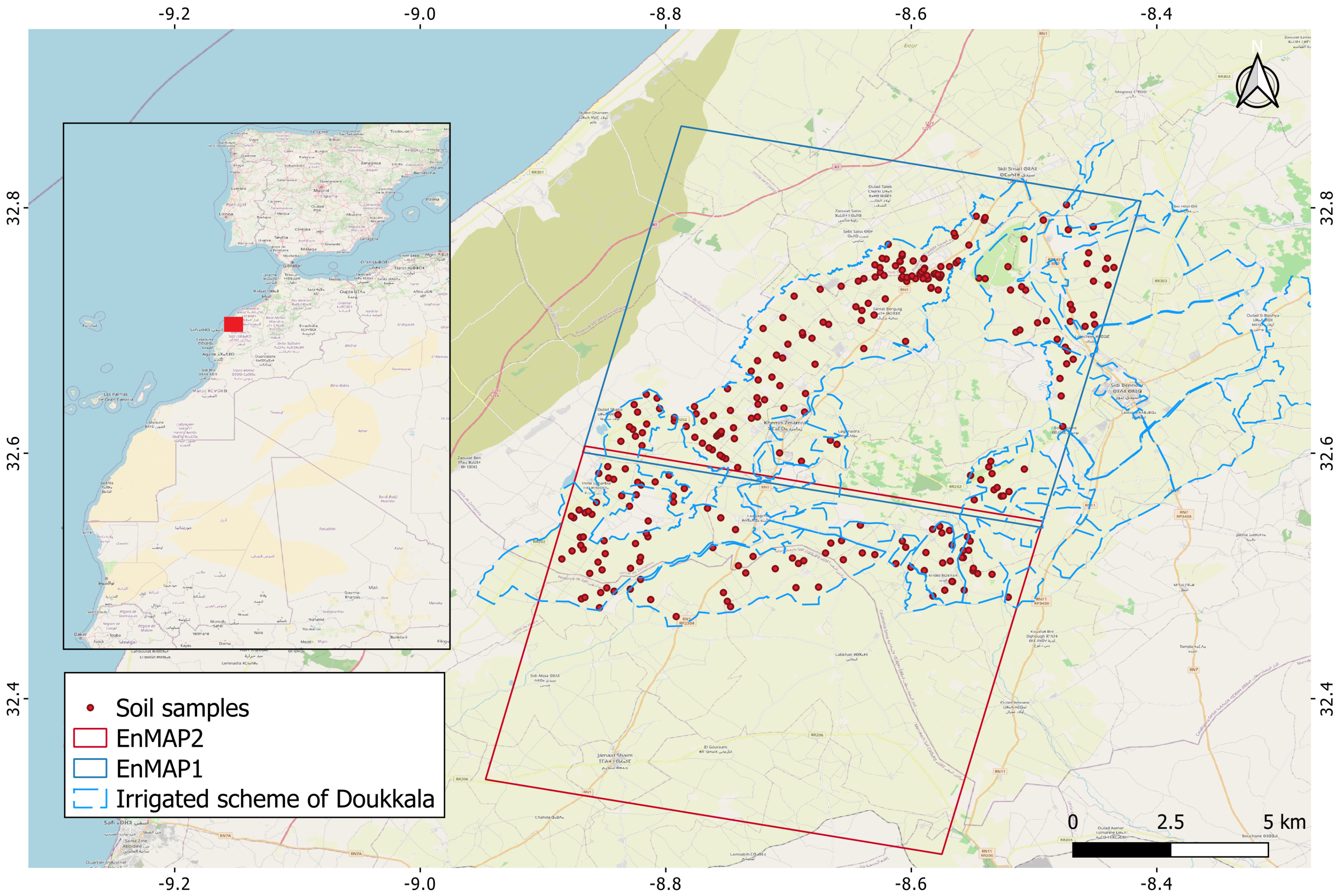
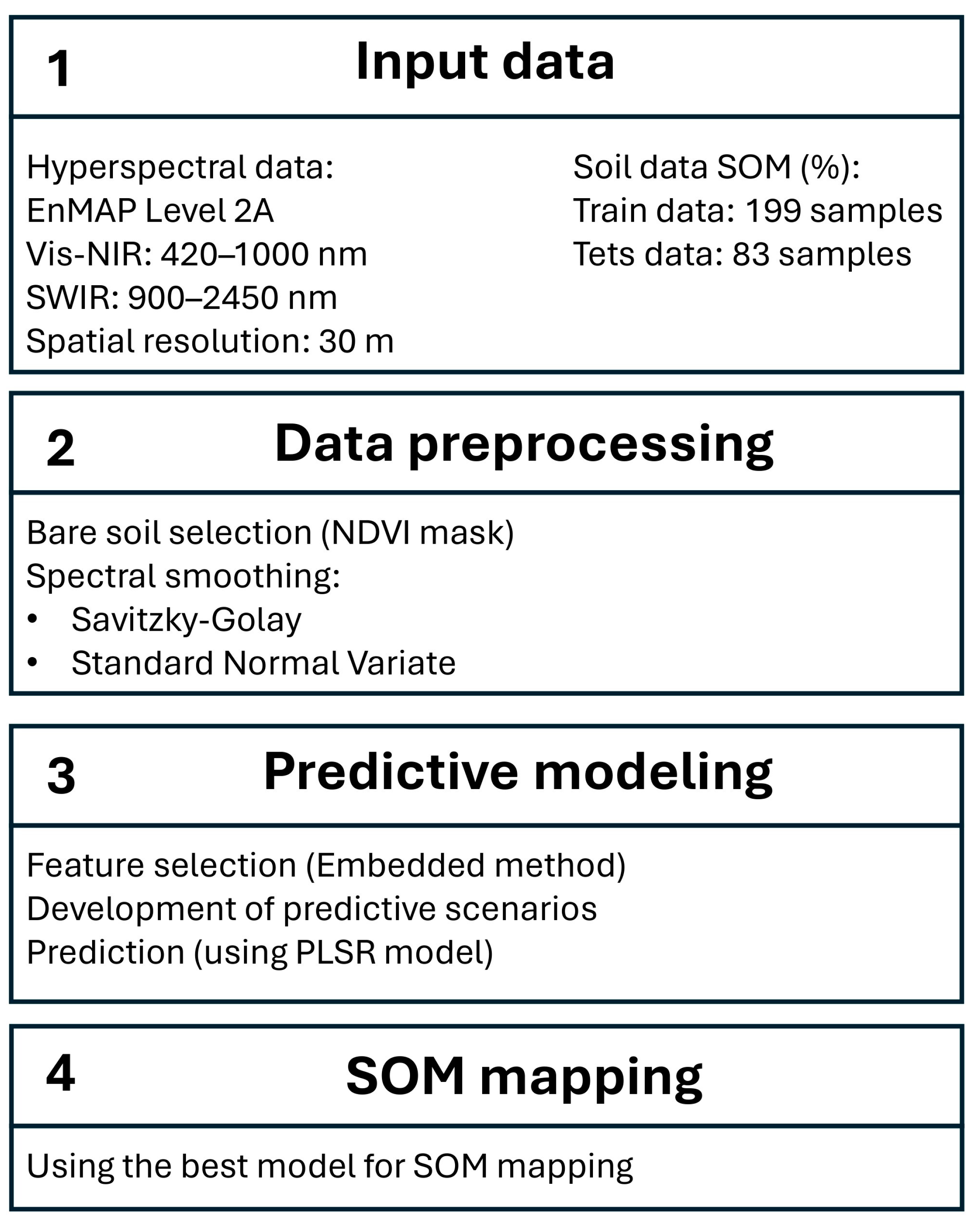
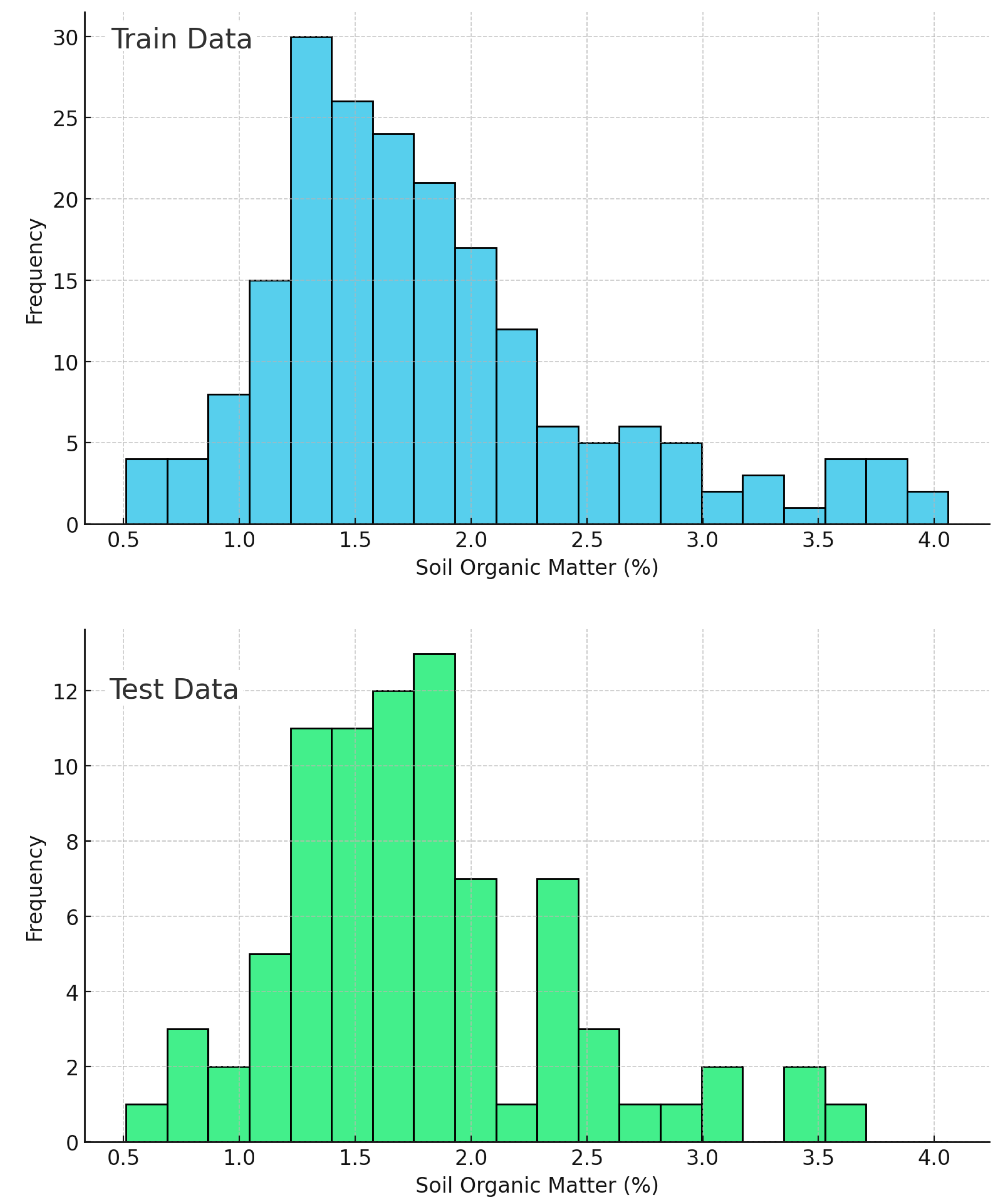

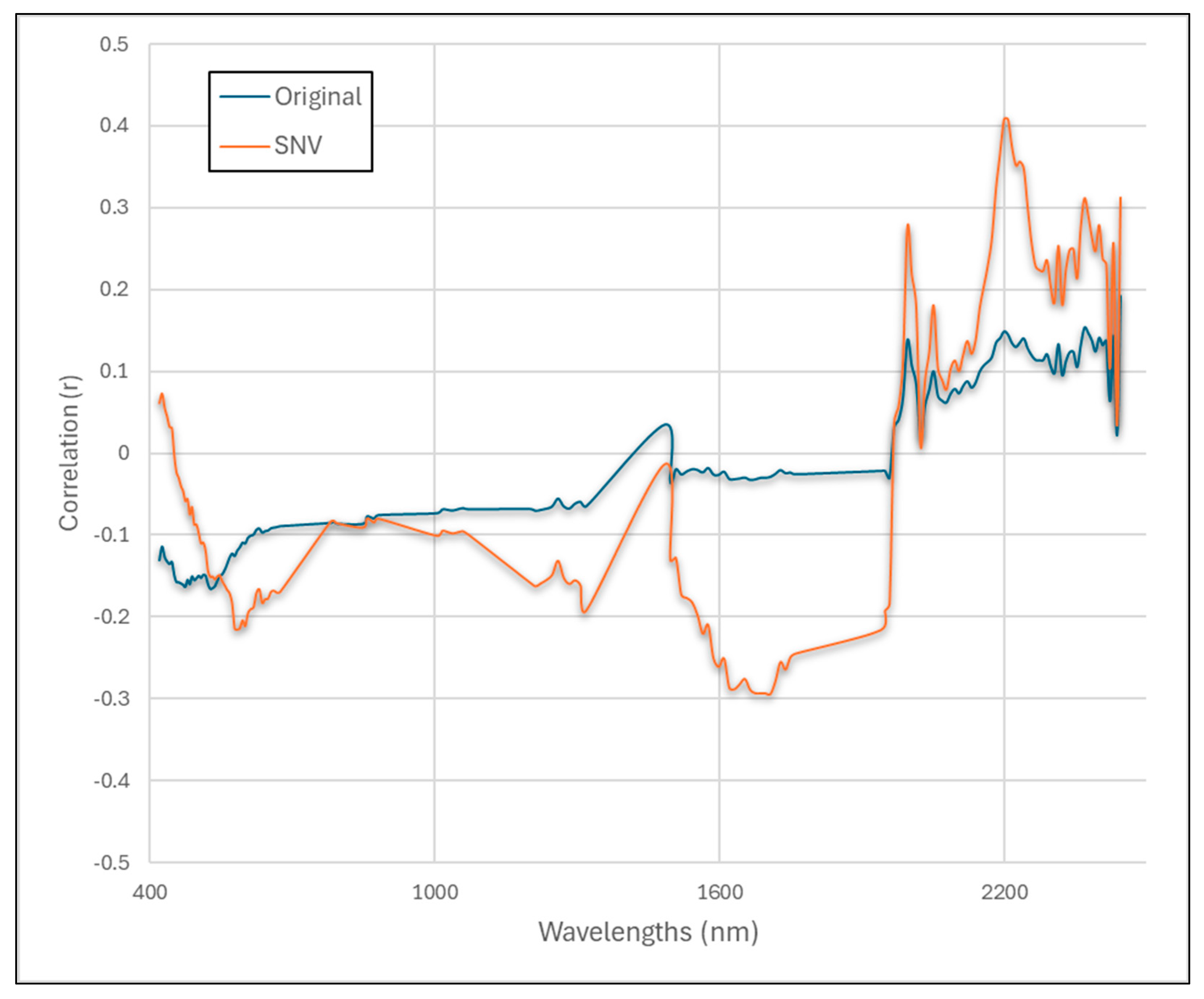
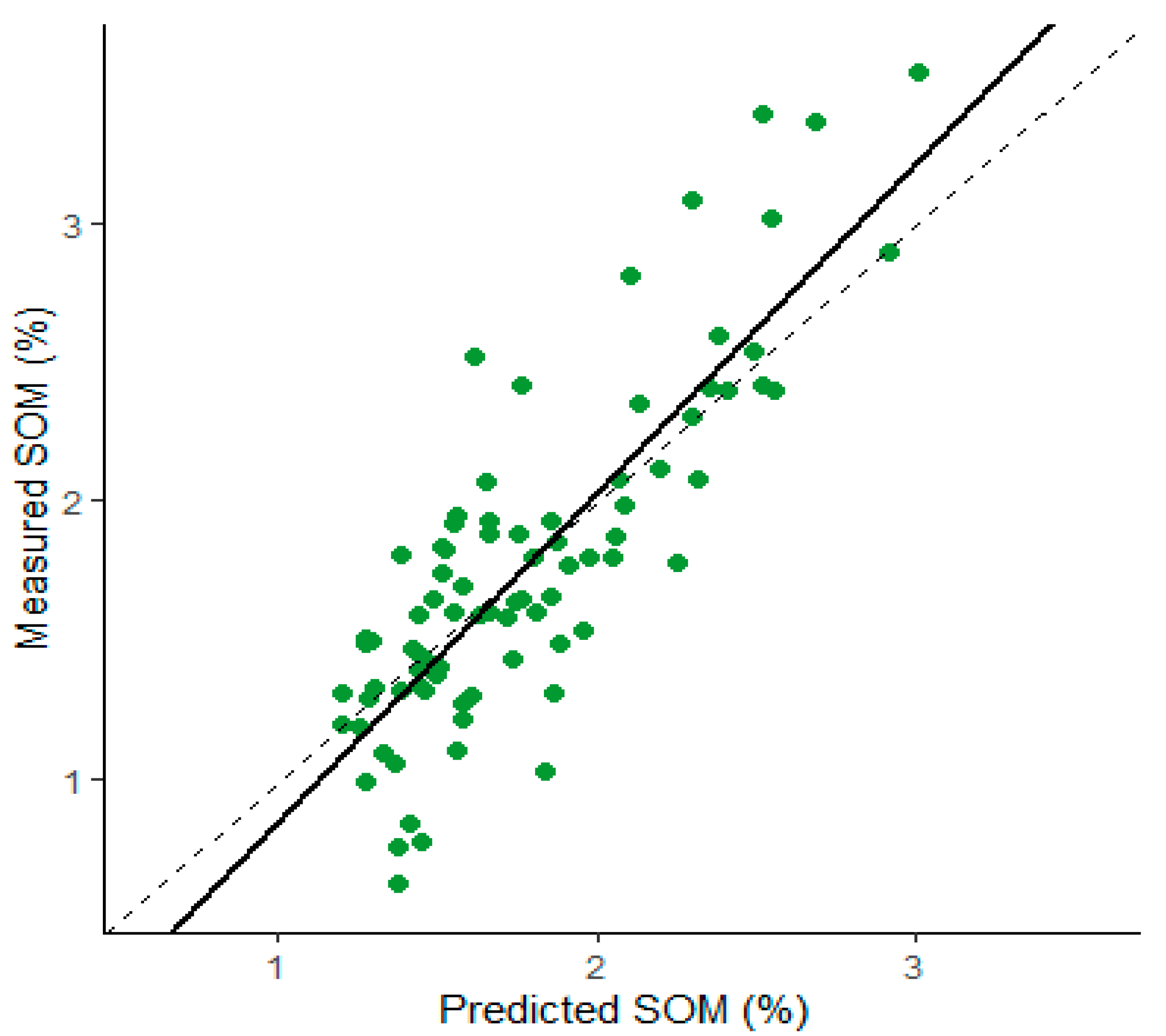
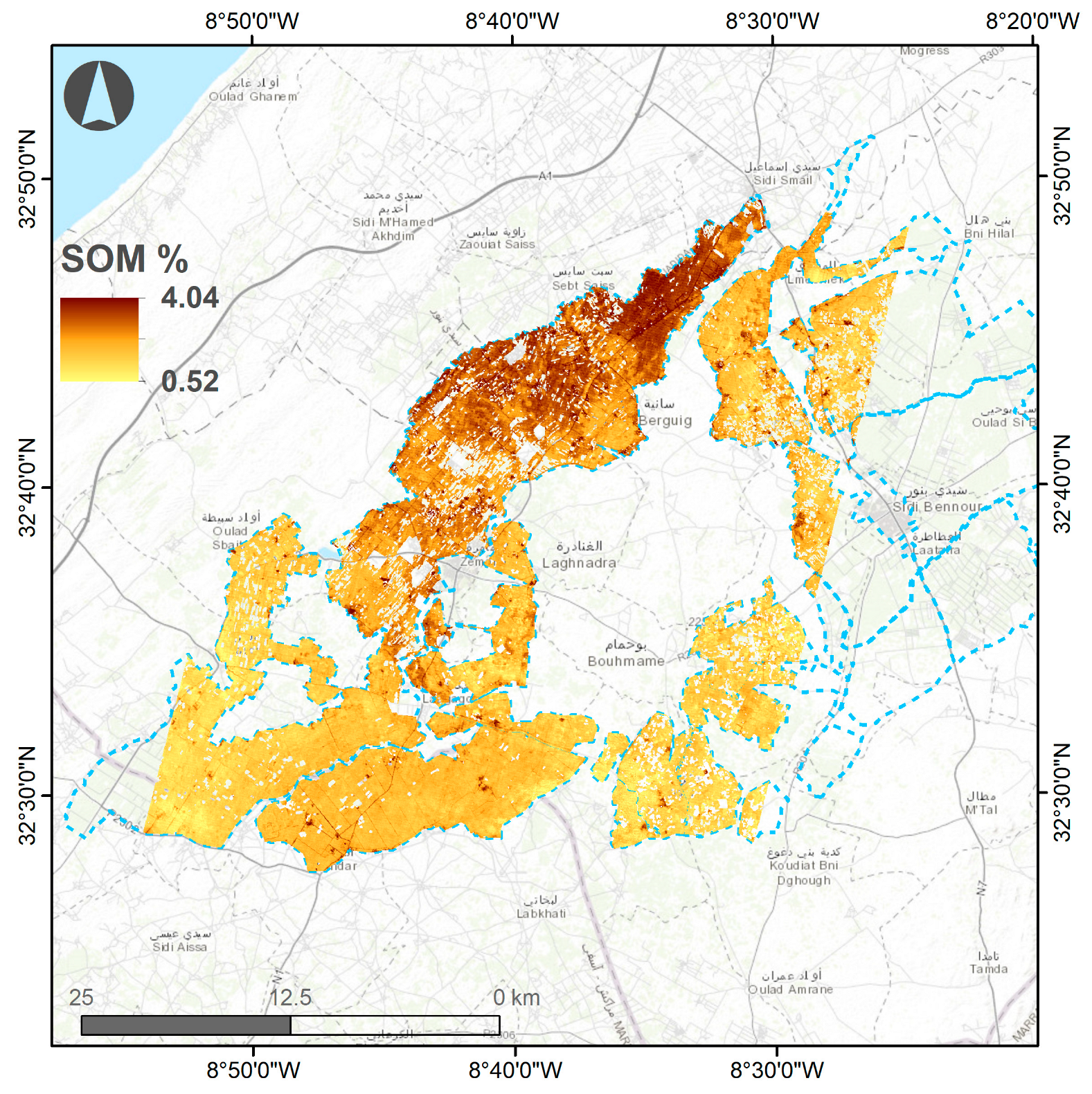
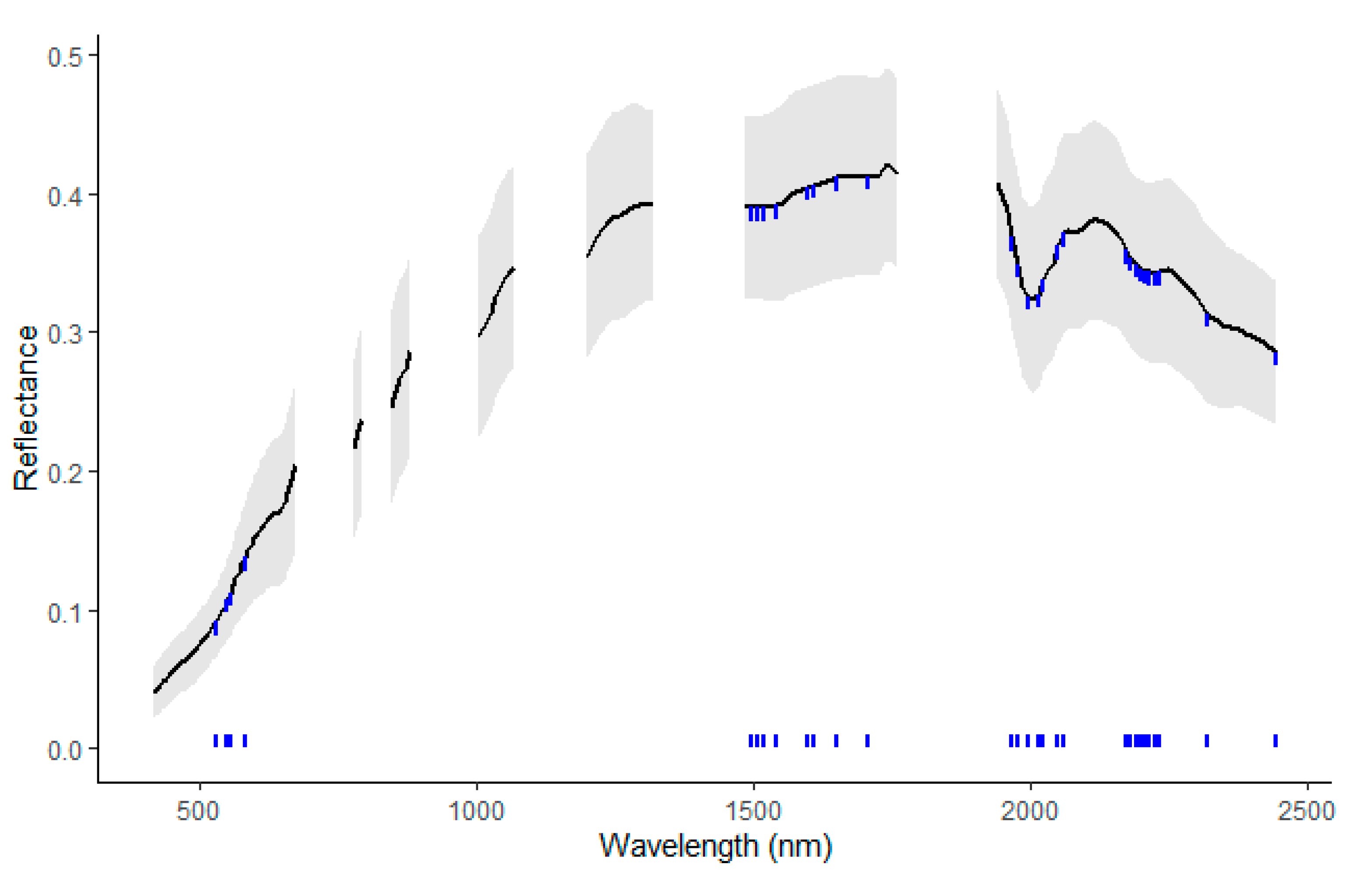
| Spectral Range | Spectral Resolution | SNR (Signal-to-Noise Ratio) | |
|---|---|---|---|
| Vis–NIR | 420–1000 nm | 6.5 nm | VNIR: >400:1 at 495 nm |
| SWIR | 900–2450 nm | 10 nm | SWIR: >170:1 at 2200 nm |
| Scenario | Preprocessing Method | Spectral Data | Description |
|---|---|---|---|
| 1 | Original | All bands | Raw spectral data without preprocessing |
| 2 | Original | 30 bands | Raw spectral data with selected top 30 bands |
| 3 | SG | All bands | Savitzky–Golay smoothing using complete EnMAP spectral data |
| 4 | SG | 30 bands | Savitzky–Golay smoothing with selected top 30 bands |
| 5 | SG_2nd | All bands | Second derivative of SG using complete EnMAP spectral data |
| 6 | SG_2nd | 30 bands | Second derivative of SG with selected top 30 bands |
| 7 | SNV | All bands | Standard Normal Variate using complete EnMAP spectral data |
| 8 | SNV | 30 bands | Standard Normal Variate with selected top 30 bands |
| N° Samples | Min | Max | Mean | Standard Deviation | Coefficient of Variation | Skewness | |
|---|---|---|---|---|---|---|---|
| Training data | 199 | 0.51 | 4.06 | 1.81 | 0.71 | 39.46 | 1.08 |
| Test data | 83 | 0.63 | 3.54 | 1.77 | 0.6 | 33.9 | 0.86 |
| Model | R2 | RMSE (%) | RPIQ |
|---|---|---|---|
| Original | 0.60 | 0.39 | 1.56 |
| Original and 30 F | 0.53 | 0.43 | 1.41 |
| SG | 0.58 | 0.39 | 1.53 |
| SG and 30 F | 0.56 | 0.41 | 1.47 |
| SG2nd | 0.58 | 0.39 | 1.53 |
| SG2nd and 30 F | 0.52 | 0.42 | 1.43 |
| SNV | 0.67 | 0.34 | 1.74 |
| SNV and 30 F | 0.68 | 0.34 | 1.75 |
Disclaimer/Publisher’s Note: The statements, opinions and data contained in all publications are solely those of the individual author(s) and contributor(s) and not of MDPI and/or the editor(s). MDPI and/or the editor(s) disclaim responsibility for any injury to people or property resulting from any ideas, methods, instructions or products referred to in the content. |
© 2025 by the authors. Licensee MDPI, Basel, Switzerland. This article is an open access article distributed under the terms and conditions of the Creative Commons Attribution (CC BY) license (https://creativecommons.org/licenses/by/4.0/).
Share and Cite
Bouslihim, Y.; Bouasria, A. Potential of EnMAP Hyperspectral Imagery for Regional-Scale Soil Organic Matter Mapping. Remote Sens. 2025, 17, 1600. https://doi.org/10.3390/rs17091600
Bouslihim Y, Bouasria A. Potential of EnMAP Hyperspectral Imagery for Regional-Scale Soil Organic Matter Mapping. Remote Sensing. 2025; 17(9):1600. https://doi.org/10.3390/rs17091600
Chicago/Turabian StyleBouslihim, Yassine, and Abdelkrim Bouasria. 2025. "Potential of EnMAP Hyperspectral Imagery for Regional-Scale Soil Organic Matter Mapping" Remote Sensing 17, no. 9: 1600. https://doi.org/10.3390/rs17091600
APA StyleBouslihim, Y., & Bouasria, A. (2025). Potential of EnMAP Hyperspectral Imagery for Regional-Scale Soil Organic Matter Mapping. Remote Sensing, 17(9), 1600. https://doi.org/10.3390/rs17091600










